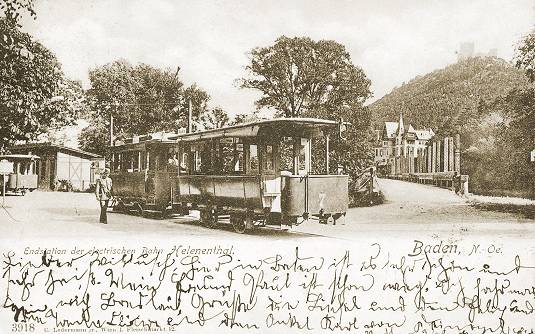

Our postcard is of the Rauhenstein-Helenental (old spelling, Helenenthal) terminus of the scenic valley tramway from Baden bei Wien (Baden, 25-30km south-west of Vienna) that lies 3.2km (approx. two miles) to the east. On the hill to the right are the ruins of Burg Rauhenstein where, in 1826, Ludwig van Beethoven's nephew Karl (they both lived in Vienna at the time) attempted suicide with two pistols - but missed twice! The Baden tramway was one of the oldest in former Austro-Hungary and was opened in 1873 by the Badener Tramway Gesellschaft as a standard gauge horse tramway.
The tramway network was special in its time for having both town and interurban or overland character; although within the town itself there was (eventually) only one route, a circular. The tramway had its problems. Being a spa town, the tramway was seasonal and, for many years, it only operated between 1 May and 15 October. In 1882 it was sold to the Südbahngesellschaft which opened the first section of the circular town route in 1883, but which was not completed until 1899.
On 16th July 1894, the horse tramway between Baden and Rauhenstein/Helenental was electrified, making it the first standard gauge electric tramway in Austria (electric trams didn't run in Vienna until 1897). Over several years, a few other routes radiating out from Baden were added. Overhead line voltage was 550V DC. Between 1873 and 1885 the company had built up a fleet of 18 horse trams, all of which became trailers on the new electric tramway.
By the date of our postcard, (1905), there were also 18 motor trams, mostly built by J.Weitzer in Graz with two by Maschinenbau AG in Nuremberg (now M.A.N., the well-known truck and bus builder). The postcard view shows 'summer' trailer no.7 of 1873 (built by Hernals) behind one of the original 1894 Graz-built motor cars of the series 101-110 that have just arrived at Rauhenstein terminus. As delivered, these trams had two, rather puny, 8hp motors operated by a simple on-off switch on the platform (requiring considerable driver skills) rather than a familiar stepwise controller. Electrical equipment was by Schuckert & Co., Nuremberg. In later years, there were several upgrades to more powerful motors and 'real' controllers. There was seating for 18 passengers. In the background on the left is trailer car no.13, one of the same batch as no.7.
Today, the road to the right (Helenenstrasse) is also designated as the B210 and a hotel occupies the site behind the trams, which is at the eastern end of Promenadegasse. The waiting room seen on the left no longer exists but has been replaced by a substantial brick-built bus shelter and toilets.
There were numerous plans for further extensions, most of which came to nothing. Weekday services on the Helenental route closed in 1931 and all of the independent town tramway system had closed before WW2. Trailer car no.4 of 1884 and motor tram of 1900 built in Graz have been restored and can be seen at the Mariazell Tramway Museum in Austria. It is still possible to travel by tram to Baden because an old section of route between there and Guntramsdorf forms the southernmost section of the Wiener Lokalbahn (WLB), a tramway that runs approximately 30km out from central Vienna.
The card was published by C.Ledermann Jr. of Vienna with serial number 3918 and posted from Baden to Karlsbad, then in German-speaking Bohemia. Today, Karlsbad is known as Karlovy Vary in the Czech Republic. Sadly, the message does not mention the trams.
![]() Go to Postcard Of The Month Index
Go to Postcard Of The Month Index